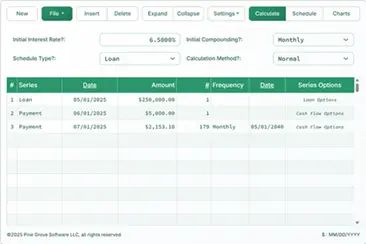How to Calculate a Loan with a Series of Extra Payments
To set your preferred currency and date format, click the “$ : MM/DD/YYYY” link in the lower right corner of any calculator.
A Step-by-Step Tutorial
Tutorial 10
Borrowers can reduce total interest costs by making small, regular extra payments toward the loan’s principal balance. This tutorial explains how to calculate the effect of a recurring extra payment on the total interest paid and the loan term. It differs from the previous tutorial, which focused on a single, one-time extra payment. In this tutorial, each regular payment is increased by a fixed amount. The tutorial is designed to help users create accurate schedules using the financial calculators provided.
Before continuing, all users should complete the more detailed initial tutorial to understand the basic concepts and settings of the Ultimate Financial Calculator (UFC).
To create a loan schedule with a series of extra payments, follow these steps.
- Set Schedule Type to Loan.
- Alternatively, click to clear any existing entries.
- Click , then select . Set “Rounding” to Open balance — no adjustment.
- In the header section, apply the following settings:
- Select Normal for Calculation Method.
- Set Initial Compounding to Monthly.
- Enter 6.5 for Initial Interest Rate.
- In row 1 of the cash-flow input area, create a “Loan” series.
- Set the “Date” to May 1, 2024.
- Set the “Amount” to 255,600.00.
- Set “# Periods” to 1.
- Note: Because the number of periods is 1, you will not be able to set a frequency. If a frequency is entered, it will be cleared when you exit the row.
- Go to the second row of the cash-flow input area. Select “Payment” for the “Series”.In this example, you will create a loan schedule with monthly payments over 30 years.The regular payment amount is not known yet.
- Set the “Date” to June 1, 2024.
- Set the “Amount” to “Unknown” by typing U.
- Set “# Periods” to 360.
- Set the “Frequency” to Monthly.

- Click . The result is $1,615.57.

- To see the total interest before applying extra payments, click .

- Adjust the periodic payment to include the extra-payment amount.
- Click on the button bar.
- The schedule should now contain 361 rows: one loan row and 360 payment rows.
- For this example, increase each payment by $200.00.
- To apply the change to all rows, first adjust one payment, then collapse the schedule.
- Click on the button bar.


- Scroll the cash-flow area to row thirty-nine. Change the payment amount for the 38th payment on July 1, 2027 from $1,615.57 to $1,815.57.

- Click . This will reduce the schedule to four rows.
- Click row 4 (the next row after the adjusted payment), and change the payment amount to $1,815.57 to apply the same amount to all remaining payments.
- Change “# Periods” to “Unknown”.
- This prepares the calculator to determine the new loan term that includes the extra-payment amount.

- Click . The unknown value is 244.
- The new term consists of 282 total payments (37 + 1 + 244).
- To view the impact of the extra payments on total interest, click .

(326,000.91 − 249,762.48)
Making extra payments to prepay principal can significantly reduce total interest charges.Because of the time value of money, earlier extra payments create greater savings.This calculator and the Extra Payment Calculator allow you to calculate the exact reduction in interest.
Back to the Ultimate Financial Calculator.
